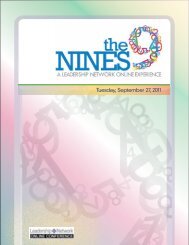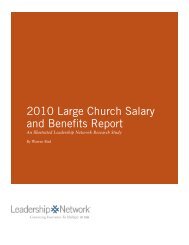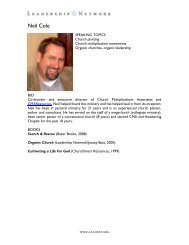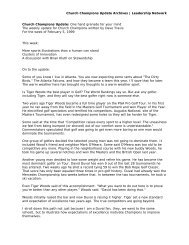ARE WE A PEOPLE AT HALF TIME? - Leadership Network
ARE WE A PEOPLE AT HALF TIME? - Leadership Network
ARE WE A PEOPLE AT HALF TIME? - Leadership Network
Create successful ePaper yourself
Turn your PDF publications into a flip-book with our unique Google optimized e-Paper software.
-*gFJ<br />
Jaw, as never before. the AK I 3 need a strong a~olol- lemon st rat in^ thpl<br />
r BU3rLl rdvancinpthe Yk<br />
-," 5 6<br />
honor to Gc -.<br />
relationship to the creative arts. Our<br />
response will to some degree determine<br />
our effectiveness and relevance in future<br />
ministry. Church history and recent<br />
cultural changes give us a glimpse as to<br />
why this is so important.<br />
"...Music was to m extent still mptabk to<br />
tFRnz [Puritans]. The other artsfared wurst...<br />
the Calvinistic a d Puritan m mnts had<br />
virtually IW appreciation fur the fine av ts... the<br />
arts were in thlves wurldly, unholy and...<br />
a C'vristian shId wer parhipate in them."<br />
H.R. Rookmaaker<br />
renowned Christian art historian<br />
THE REFORM<strong>AT</strong>ION During the<br />
Reformation, the link between artistic<br />
and sacred was severed in the Protestant<br />
church. Overzealous reformers,<br />
attempting to purge the church of idols<br />
and corrupt practices, destroyed<br />
centuries of religious art. Some Puritans<br />
ransacked cathedrals and destroyed<br />
stained glass, paintings, tapestries and<br />
even communion vessels. They<br />
whitewashed artwork on the walls and<br />
turned seating face forward in austere<br />
school-like fashion. Singing and<br />
instrumentation nearly ceased. Artists<br />
were deemed sinful and worldly.<br />
While singing and limited<br />
instrumentation returned fairly rapidly,<br />
other art forms were suspect and<br />
scorned. The pervasive shunning of<br />
artists and deep-seated distrust of arts<br />
can still be seen today. There is a "tide<br />
of distrust about creative efforts that<br />
lurks around our Christian enclaves,"<br />
states Howard G. Hendricks, chairman<br />
of the Center for Christian <strong>Leadership</strong><br />
at Dallas Theological Seminary.<br />
CRE<strong>AT</strong>ING AN ALTERN<strong>AT</strong>E<br />
UNIVERSE Throughthe1g5o's,<br />
mainstream culture and the church<br />
shared similar Judeo-Christian values.<br />
Then society entered a forty-year<br />
period of unprecedented change.<br />
Traditions were questioned and often<br />
discarded. In reaction to cultural shdts,<br />
Christians were urged to abstain from<br />
movies, dance, Rock n' Roll and<br />
performing or visual arts. Sermons were<br />
preached and books written to<br />
discourage involvement in secular arts.<br />
As many frustrated Christians<br />
withdrew from mainstream life, a<br />
Christian subculture emerged.<br />
The late Emmy Award-winning TV<br />
producer, Bob Briner said, "In the arts,<br />
entertainment, media, education, and<br />
other culture-shaping venues ... the<br />
church has abdicated its role as salt and<br />
light.. .we have created a phenomenal<br />
subculture with our own media ... our<br />
subculture is healthy. It's the world that<br />
needs help.. .instead of running from it,<br />
we need to rush into it." However,<br />
most of the church ran from culture<br />
and abandoned culture-shaping arenas.<br />
Church consultant Sally Morgenthaler<br />
observed, "We are so imploded in our<br />
own subculture that we are cut off from<br />
the rest of culture." When Christian<br />
artists ventured into mainstream, they<br />
paid a painful price.<br />
THE CROSSOVER PRICE Since<br />
art was worldly and artists sinful,<br />
Christians who "crossed over," meaning<br />
their art reached into the world, found<br />
themselves the subject of anger and<br />
scorn. Instead of celebrating their<br />
entering the secular arena, Christians<br />
protested and even banned their work.<br />
Amy Grant's crossing over angered<br />
thousands. Her records were returned<br />
and angry letters written. Inside the<br />
church, it was equally difficult for<br />
artistic believers. Musicians by the<br />
thousands were squelched. Dancers<br />
were discouraged. Actors were often<br />
forbidden to enter that heathen world.<br />
Sculptors had no place for their work.<br />
Fiction writing was deemed worthless.<br />
Painting was frowned upon. Many<br />
artists abandoned their art or their faith.<br />
ART OR FAITH Inthe 1960's,<br />
Rookmaaker offered this prescient<br />
observation, "As the younger<br />
generation born and raised w i h these<br />
circles comes to understand the<br />
importance of the arts, all kinds of<br />
problems and tensions arise.. .Many<br />
have turned away from Chstianity or<br />
more tragically, from Christ, as they<br />
have come to feel that 8th<br />
vital aspect<br />
of human Me is outside religion or faith,<br />
then somethmg basic must be defective<br />
in the faith."<br />
Dan is a musician and songwriter. He<br />
found percussion, then absent in<br />
church, added passion to music - but<br />
he lived in an evangelical home in the<br />
60's. His parents, armed with Christian<br />
books on the evils of music with beat,<br />
demanded his music be destroyed.<br />
Forced to choose between art and faith,<br />
he chose faith without passion.<br />
(mtinlled on page 12)







